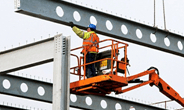Analysis

May 23, 2023
AGC: Construction Jobs Decline in More than Half of States in April
Written by David Schollaert
Less than half of US states added construction jobs in April, according to Associated General Contractors of America (AGC) figures. Despite the poor employment showing vs. month-ago totals, more than three-quarters of states added construction jobs year-on-year (YoY), the report said.
![]() The poor month-on-month (MoM) performance is likely a result of low unemployment rates and workforce shortages rather than a decline in construction activity, the report said.
The poor month-on-month (MoM) performance is likely a result of low unemployment rates and workforce shortages rather than a decline in construction activity, the report said.
“Contractors continue to report strong demand for projects and have added employees in all but a handful of states over the past year,” said Ken Simonson, AGC’s chief economist. “The fact that employment dipped in April in half the states may reflect an inability to find qualified workers at a time of record-low construction unemployment, not a slowdown in demand.”
For the month, construction employment increased in 24 states and Washington, D.C., while declining in 26 states. Washington state added the most jobs over the month, a boost of 4,300 jobs, or a 1.8% increase vs. March, followed by Illinois, Wisconsin, and California. The largest percentage gains occurred in South Dakota, up 2.7%, or 700 added jobs, followed by Wisconsin, Washington, Arkansas, and Louisiana.
Texas experienced the largest decline in construction jobs in April when compared to the prior month, a decrease of 8,500 jobs, or 1.1% lower, followed by New York and Kentucky. Alaska had the largest percentage loss for the month, down 4.2%, or 700 fewer jobs, followed by Rhode Island.
Construction employment increased in 42 states and the District of Columbia YoY in April. Industry employment declined in seven states and was unchanged in Hawaii over the period.
Texas added the most jobs over the past year, adding 28,000 jobs, or a 3.6% increase, followed by New York, Indiana, and Florida. Arkansas had the largest percentage increase, up 9.8, or 5,500 jobs, followed by Rhode Island, Indiana, Nebraska, and Idaho.
By comparison, California lost the most jobs, with 5,100 fewer jobs, or a 0.6% decrease, while West Virginia had the largest percentage loss at -3.7%, or 1,200 fewer jobs. Losses also occurred in Connecticut, West Virginia, and Colorado.
The report added that construction firms continue to pay premium wages, well above the national average to draw workers. AGC cautioned that the trend is unlikely to change if federal officials continue to limit exposure to career opportunities in the sector.
“Public officials at the state and federal level don’t seem too eager to encourage students to pursue careers in fields like construction,” said Stephen Sandherr, AGC’s CEO. “If we want the workers we need to rebuild our infrastructure and modernize our economy, we need to invest in construction-focused education.”
By David Schollaert, david@steelmarketupdate.com







